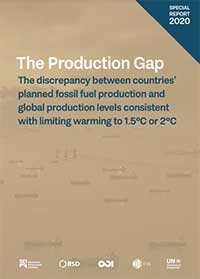Production Gap Report of United Nations and related organization
A special issue of the Production Gap Report – from leading research organizations and the UN – finds that the COVID-19 recovery marks a potential turning point, where countries must change course to avoid locking in levels of coal, oil, and gas production far higher than consistent with a 1.5°C limit.
According to the 2020 Production Gap Report , Countries plan to increase their fossil fuel production over the next decade, even as research shows that the world needs to decrease production by 6% per year to limit global warming to 1.5°C.
This year’s special issue looks at the implications of the COVID-19 pandemic – and governments’ stimulus and recovery measures – on coal, oil, and gas production. It comes at a potential turning point, as the pandemic prompts unprecedented government action – and as major economies, including China, Japan, and South Korea, have pledged to reach net-zero emissions.
What production gap report measures ?
The report, first launched in 2019, measures the gap between Paris Agreement goals and countries’ planned production of coal, oil, and gas. It finds that the “production gap” remains large: countries plan to produce more than double the amount of fossil fuels in 2030 than would be consistent with a 1.5°C temperature limit.

Who prepares this report ?
The report was produced by the Stockholm Environment Institute (SEI), the International Institute for Sustainable Development (IISD), the Overseas Development Institute, E3G, and UNEP. Dozens of researchers contributed to the analysis and review, spanning numerous universities and additional research organizations.
Main findings of the Production Gap Report :
- To follow a 1.5°C-consistent pathway, the world will need to decrease fossil fuel production by roughly 6% per year between 2020 and 2030. Countries are instead planning and projecting an average annual increase of 2%, which by 2030 would result in more than double the production consistent with the 1.5°C limit.
- Between 2020 and 2030, global coal, oil, and gas production would have to decline annually by 11%, 4%, and 3%, respectively, to be consistent with the 1.5°C pathway.
- The COVID-19 pandemic – and the “lockdown” measures to halt its spread – have led to short-term drops in coal, oil, and gas production in 2020. But pre-COVID plans and post-COVID stimulus measures point to a continuation of the growing global fossil fuel production gap, risking severe climate disruption.
- To date, G20 governments have committed over US$230 billion in COVID-19 measures to sectors responsible for fossil fuel production and consumption, far more than to clean energy (roughly US$150 billion). Policymakers must reverse this trend to meet climate goals.







